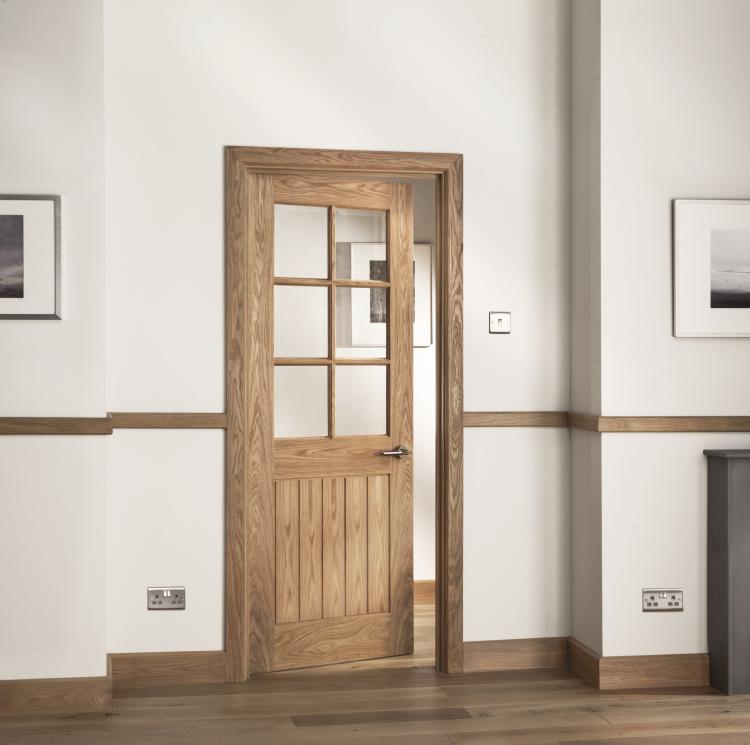
Read on to find help and guidance on how to trim an Internal Door...
Hello and welcome to our four-part guide series that will take you through the steps on how to hang an interior door, how to trim an interior door if it is too big, how to fix door furniture, and how to finish a door. Whatever your background – from an experienced tradesperson to a weekend DIY’er – hopefully you will come out the other side with some great tips and best practices that you can take away with you and apply to your interior home development projects.
The second article in the fortnightly series is a step by step guide on how to trim an interior door. If you want to know more about hanging an interior door, click here to be directed to our last article where you can find more information.
Over time, you might find that your interior doors become a nuisance to open and close. In most cases, simply tightening the hinge screws will do the trick, but occasionally due to structural movement or warping, you might need to trim the door. The same will often apply after buying a new interior door or installing new flooring; particularly carpet. If the difference is only slight, you may be able to get away with sanding a little material off the bottom of the door. If the door is ever so slightly catching the floor, instead of taking the door off its hinges, use a piece of sandpaper (on top of a thin plank of wood or cardboard), place it under the open door, and then open and close the door until the problem is solved. If there is a large difference, you will need to plane the door. To plane a door, you will first need to identify the problem areas, prepare the door, remove wood gradually, and check your work as you go.
If you are unsure after reading this article, Blueprint Joinery always recommends getting a local trades person involved as mistakes can be costly. We also recommend referring to your product fitting instructions at all times of the installation process. All our fitting guides can be found here on the website.
Recommended equipment
Below is a list of tools and equipment useful for trimming an interior door:
- A tape measure
- Pencil
- Workbench
- Clamps or straps (used to secure the door to the workbench when trimming)
- Masking tape (used to protect sections of the door not being trimmed)
- Wood chisel
- Rubber mallet
- Plane power tool
- Hand saw
- Door wedge (to assist in holding the door in place while hanging)
- Safety equipment including face mask and safety goggles.
An important consideration before you start
We highly recommend referring to your product fitting instructions for more detailed information on the specifications of your interior door. Depending on the type of door you have will determine how much you can safely trim without ruining the door. For example, you will not be able to shorten a hollow-core door by more than 10mm due to their construction. If on the other hand you have a solid-core, MDF or laminate door, you will be able to remove slightly more.

1 – Locate the problem areas
This step will depend on whether you are trimming an existing interior door, or you are planning to fit a new door. If it is a new door, skip to section two of this guide. If you are trimming an existing door, you will need to find where the sticking and binding areas are. You can use either 1) Identify differences in the gaps around the door, or 2) Look for areas on or around the door that show signs of rubbing, or 3) Open and close the door to locate trouble areas. Once you identify the problem areas, mark with a pencil. It is recommended to leave a gap of 4mm to 8mm at the top and bottom of the door for a perfect finish; this will depend on the type of flooring you have.
2 – Remove the door from the frame
If your interior door has removable hinge pins, you can pop them out using a screwdriver or large nail to remove the door. If not, you will need to unscrew the hinges from the door rather than from the door frame.
Top tip: It is a good idea to tape screws and pins to the hinges to avoid losing them.
3 – Lay and secure the door on a workbench
Lay the door on a stable surface such as a workbench and secure it using clamps or straps. Ensure that the door is 100
It is also important to protect the surface around the area you are planning to trim which will help prevent scuffs or marks in the event tools or equipment bang the door.
4 – Plane or saw the door
Depending on how much of the interior door you need to trim, you can either plane or saw off the marked areas at the top and bottom of the door. It is important that you adjust the plane to an angle that removes wood gradually and evenly, and you run the plane in the direction of the wood grain for a more smooth, perfect finish.
While it can be a hassle removing and rehanging the door repeatedly, it is always the best practice to prevent taking off too much wood. Fix the hinges into place temporarily with a single screw. Check the door closes flush, and the gap between the door edges and frame are around 2mm (might be slightly different at the bottom depending on the type of flooring you have) and the door is not jamming nor sticking.
5 – Finish the trimmed, exposed areas
Before applying paint or stain to the trimmed, exposed areas, we recommend sanding the exposed wood first to smooth it out. Start by firstly using a rough piece of sandpaper (around 40-60 grit) to remove large pieces of unwanted wood, and then fine sandpaper (80-120 grit) to create a smooth surface.
Apply stain to a stained interior door, and primer and paint to a painted door. Wait for it to dry; if you are happy with the finish, you are now ready to rehang the door. More information about finishing a door can be found here.
6 – Rehang the door
Position the interior door against the door frame and ensure the door is at the correct height; using a door wedge for stability will help with this part. Fix the hinges into place and make sure to tighten the hinge screws properly to prevent wilting.
Common questions
The width of our hollow-core door is slightly too big for the door frame. Is it best to plane the lock and handle side of the door, or the hinge side?
Trimming a hollow-core door, in general, can be risky; it is very easy to plane straight through to the hollow section of the door in the middle. We recommend that you first refer to your product fitting instructions to see how much you can trim. In most cases, it is best practice to sand down the door frame if possible, rather than the door.
I have recently had a new carpet fitted with thick underlay. As a result, to close the door takes some force. I am reluctant to trim the doors as they are really old. Is there anything else I can do?
There are two solutions: 1) Remove the thick underlay in that section, or 2) Use rising butt hinges rather than normal butt hinges to give you that extra floor clearance.
We have recently changed how the door swings in our living room due to a rearrange. Ever since the change, the door now sticks and scrapes on the floor. How can we resolve this issue?
It sounds like you might need to plane or sand the door. We can assume the door is only slightly out at the bottom, so instead of taking the door off its hinges, use a piece of sandpaper (on top of a thin plank of wood or cardboard), place it under the open door, and then open and close the door until the problem is solved.
